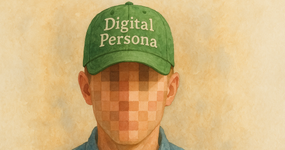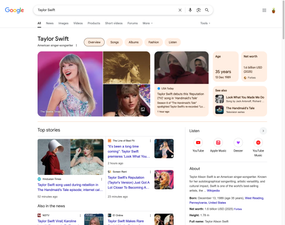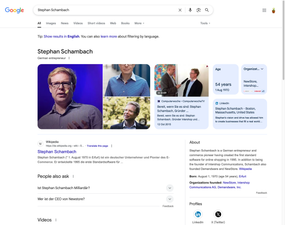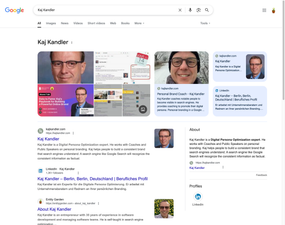What is a digital persona?

A digital persona is the aspect of a personal brand that is shaped by the person's online presence, behavior, and interactions on the internet.
In Marketing, we use the concept of a buyer persona. A buyer persona is a prototypical person who will buy a product. A buyer persona is described with attributes like age, family status, job, income, possessions, or hobbies. These descriptions facilitate a marketing team's communication between creatives, salespeople, and product managers.
For a digital persona, much is the opposite of a buyer persona. A real person leaves footprints on the Internet in the form of profiles, posts, or presentations at conferences. Search engines try to attribute various footprints to the same person in the pursuit to assemble a reflection of that person.
As you can imagine, our digital footprints never reveal a complete picture. Just like in real life, you are mindful of your social reputation, and only a subset of your true self is revealed online. That is why a digital persona is not a copy of you, but only a likeness built from your interactions online.
Also, not all human expressions lend themselves to the digital world or to the public sphere of the internet. In real life, we smell, feel, and love. Things we can not do on the internet, despite some futurists trying to develop technology to overcome this separation.
When you try to create a digital persona, you need to shape the digital footprints into a digital identity that can be understood by an algorithm. Whether it is a search engine or an AI model. Shaping your digital persona will result in a controlled representation of yourself online.
As it is impossible to avoid leaving digital footprints on the internet, you very much want to shape these into a digital persona under your control.
Examples of Digital Personas in Real Life (2025 Update)
The easiest way to discover a digital persona is to search the name on Google.
Google announced in 2012 that it collects not just words on webpages but also distills information around "things". Such things can be people, organizations, places, works of art, events, and concepts. These things build entities in Google's knowledge graph.
At Entity Garden, we take Google's Search results for a name query as the best representation of a digital persona. Because Google is the dominant search engine and has arguably the best reputation of information retrieval.
Let's look at some examples:
George Washington - The First President of the United States and a Historical Figure

George Washington's digital persona on Google boasts a comprehensive knowledge panel [1] with lots of historical facts.
Taylor Swift - A contemporary Singer and Songwriter

Taylor Swift's digital persona presents richt knowledge cards [2] and references lots of news articles. Her knowledge panel [1:1] includes places where you can listen to her music, as well as biographical information.
Stephan Schambach - An Entrepreneur and Inventor of the Online Shopping Cart

Stephan Schambach's digital persona presents knowledge cards [2:1] and social profiles where he is active. It also displays a section of also asked questions.
Types of digital personas
While anyone with an online presence has a digital persona, it may not be recognized by Google as notable enough. Truly notable people have been recognized in Encyclopedias for several hundred years.
We can distinguish between people who:
- are naturally notable due to their contribution to society, such as works of art, positions of power, inventions, etc.
- make it their mission to influence others online, through social media.
- just desire to control their own digital persona.
In encyclopedias, paid editors curate the notable people. Even Wikipedia, the largest encyclopedia the world has ever known, uses human editors to curate the world's people, organizations, and concepts.
However, Google strives to automate the process of collecting and curating the information it stores in the knowledge graph. Search engines are naturally convinced of notable people when the information about them is cited in relevant places. This applies to notable people and also to internet influencers.
However, with determination and the right actions, one can assemble a digital persona for every person.
Look at Kaj Kandler's (yours truly) Digital Persona in Google as an example of someone "famous on Google" w/o being worthy of a Wikipedia entry.
Kaj Kandler - Digital Persona Expert and Founder of Entity Garden

Kaj Kandler's digital persona on Google shows knowledge cards [2:2] and a knowledge panel [1:2]. In the core search results it has links to major websites that describe this person. On top is Kaj Kandler's personal website, which also functions as his digital persona hub.
Digital Persona vs Digital Footprint: What’s the Difference?
The main difference between a digital persona and digital foorprints is the scope of the effort. A digital persona emerges through many digital footprints left by activity on the Internet.
Digital footprints are small, often disconnected utterances on the internet. A social media post is connected to its author's profile and vice versa, but they often exist in small islands on a platform.
A digital persona is truly formed when the search results page [3] for the "name query" is dominated by information and links to webpages about the same person. If the person is included in Google's knowledge graph, the search results may further include rich results sections, such as a knowledge panel and knowledge cards [2:3].
A digital footprint is any small piece of text that talks about a person or is connected to their author. Digital footprints are the pieces that a search engine tries to assemble into a whole picture of the persona.
In order to achieve this, Google's algorithms must extract specific information (name, birthday, relations to other things, ...) from the text and collect it under an identity. It is a hard problem to guess that identity correctly. As you may know, people sometimes write their name differently, change their name, and names can be identical for many people.
Therefore, Google also analyses related things in the text, such as topics mentioned in context with the name, things (employers, books, songs, movies, organizations, ...) in relation to the name. For example: "John Doe was born in Los Angeles" or "John Doe wrote the book 'Three Stars Over the City of Angels'"
Only when extracted information is found repeatedly, Google take the information as fact. It stores such facts in its knowledge graph.
Understanding the process, how knowledge graphs are formed, we can teach it the facts about our personal brand. Leveraging context, clear statements, and repetition, we can force Google to see us as worthy of a spot in the knowledge graph.
Why Is Your Digital Persona So Important?
Your digital persona is important because it combines your business card with your reputation. people rely on the information they can find about you online.
It is impossible to avoid digital footprints in a world of social media. It is further impossible to keep Google from putting pieces together into a persona.
Last but not least, people are looking for you online, and they want to find your digital persona.
Did you know 70% of people in human resources search a candidate's name to uncover potential red flags? And not only HR people search. So do salespeople and new professional contacts. We also connect in professional communities online and seek to meet new people.
It does not end here. Among Gen-Z, they search on Google for anyone they meet. Whether it is a date, a friend of a friend, a stranger, an artist, or a new colleague, they look them up, often on the spot.
Being aware of your digital persona and controlling its content shapes your professional and personal reputation. Your digital persona helps to shape your social networking, which happens increasingly online. Furthermore, your safety may depend on private information not becoming part of your digital presence.
How to Audit Your Current Digital Persona
If you now search your digital persona, you want to assess how good or bad it is.
You can audit your digital persona by taking the following steps:
- Search for your name (Pro Tip: Search for all variations you may have used)
- Count the relevant entries of the search results
- Assess any rich results awarded by Google Search
- Make a list of all social profiles you control
Now you have a basis to manage your digital persona. You can take action and review your social profiles, correct any false or outdated information, and link together all pages that represent you and what you want to be known about you.
For details, read "How to self-audit your digital persona."
Conclusion: Your Digital Persona Shapes Your Future
What search engines, and increasingly AI Models, present about you is the modern equivalent of a very comprehensive business card.
You can not prevent search engines from representing your digital persona. People you meet seek that information and might be misled by mistakes the machines make.
It's in your power to take control of your digital footsteps. You can shape your digital persona by helping search engines to connect the different profiles and associated content.
Start managing your digital identity by:
- Auditing your digital persona
- Building and managing your digital persona
Knowledge panels are information boxes that appear on Google SERP when you search for entities (people, places, organizations, or things) that are in the Knowledge Graph ↩︎ ↩︎ ↩︎
Knowledge cards are a grid of small information cards across the top of the SERP. Knowledge cards are only shown for entities in the Google Knowledge Graph ↩︎ ↩︎ ↩︎ ↩︎
The search engine results page, or SERP, is the page you see in response to a query into Google, Bing, Yahoo, or any other search engine. ↩︎